September 11th, 2009 · 1 Comment
Yesterday we all went to the Pitmen Painters at the National Theater. I greatly enjoyed the show however I found it sad, yet sadly true. The story is about five Pitmen who are able to take an art appreciation class thanks to the WEA (workers education association). Their teacher, Mr Lyons, soon realizes that the Pitmen know nothing about art and decides to have them learn through painting their own works. As the Pitmen progress they catch the eye of heiress and art enthusiast Helen Sutherland. Helen buys some of their paintings and is at first astounded by the honesty in their works. She also attempts to pay Oliver, one of the pitmen, a weekly wage so he can paint without the interference of his pitmen work. Eventually Helen grows bored with Oliver’s work and moves on.
Helen claims that she and Oliver met across the boundaries of class, but I really find this to be untrue. I think that Helen only appreciated the Pitmen’s art because it was a commodity for her. She wanted to OWN Oliver and his work like she would any other commodity. And just like with any other commodity she soon grows bored with him and moves on to other more trendy things.
During the scene of the Pitmen’s first art show everyone, including Lyons, is refering to the Pitmen as Pitmen who can paint, rather than as individual artists. The only reason the Pitmen became popular was because they were working class not because they were talented (though they were). Lyons was selling the work of these working class men by making the fact that they were working class a commodity, and therefore made them a novelty. In a way, he advertised them like monkeys in a cage at the zoo or as some sort of side show act “come see the Pitmen Painters! Have you ever seen anything like them? See the working class does have talent! Unbelievable! Anyone can paint!” And of course the public gets tired of the same circus act and they move on. So, the Pitmen are left the way they were before. Lyons left them, Helen left them, and their popularity left them.
I also feel that Lyons used the Pitmen for his own gain, almost like “look what I got these monkeys to do! I could teach anyone, why don’t you hire me?” At one point in the play Oliver asks Lyons “why can’t I live like this? Why couldn’t this be me?” he also says “we are both mediocre artists, why can I be in the place you are?” (Note: not direct quotations, but something very similar) And the reason is of course class. The bourgeoisie is forever exploiting the proletariat, and the proletariat is forever being held down by the bourgeoisie. It is only after the painting class that Oliver is finally able to eliminate his false consciousness and see what was going on the whole time, just to be put back in the same place he was before when Lyons says “well if you want the world to change, you will have to change it.” I love Marxism but I don’t think that the proletariat has the resources to overthrow the bourgeoisie, because part of what makes the proletariat the proletariat is their false consciousness and their inability to get past the glass ceiling. In order for the proletariat to aquire such knowledge would be for them to rise into the bourgeo themselves, which would not stop the problem but rather perpetuate it. This is would be impossible in a place like Britain in the 1930s, where and when the class devisions where so impossibly strong, and as they still are to some extent.
Tags: Rebecca
-
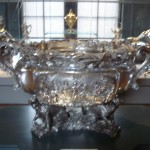
-
Giant Silver Punch Bowl at the V&A
-
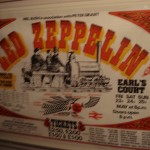
-
The Theatre and Stage Exhibit at the V&A
-

-
Brandon and I before Arcadia
-
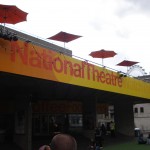
-
Outside the National Theatre
This Monday I experienced my first bank holiday. Because of our full schedule here this month it didn’t seem any different from any other day here. This held true until I wandered down Tottenham Court Road and realized that just about everything was closed. With just a handful of museums open I decided to use the time to visit one I hadn’t been to yet: The Victoria and Albert Museum.
I had been told great things about the V&A museum by classmates who had been there within the past few days so I went in with pretty high expectations. After seeing the first exhibit based on Great Britain from the 1600’s-1800’s I was not impressed. Boy would this opinion change. I walked up to the first floor and entered a giant gallery filled with all kinds of sculptures. This was easily the best sculpture gallery I had seen so far in London and I spent about 15 minutes walking through it and admiring. As I continued to walk through the entirety of the first floor I was absolutely astounded by the variety of exhibits this museum had to offer. Some highlights included a detailed exhibit on fashion, a room filled with giant monuments including a cross and decorative pillars and an exhibit on the Middle East and its textiles.
After a good hour spent on the first floor I ventured up to the third floor of the museum. As soon as I stepped into the silver exhibit I was in awe. I spent at least a half an hour admiring and studying silver used and manufactured in different time periods and parts of the world. My favourite was a giant punch bowl made entirely of silver. There were many other exciting exhibits on the third floor including one on theatre and a print exhibit featuring one of my late grandmother’s favorite authors, Beatrix Potter. My last stop on the third floor was the jewelry exhibit. In addition to being aesthetically pleasing the exhibit featured a timeline of jewelry that was considered fashionable since the start 18th century and a few small personal collections.
I could have spent at least another three hours in the Victoria and Albert museum but I decided to hold off for another day. The thing that impressed me the most about this museum was the variety of exhibits. Just about every other museum I had visited so far in London I knew what to expect going in. The V&A featured anything and everything and had no qualms about doing so. I found this both refreshing and exciting.
The rest of my bank holiday was filled with a trip to the theatre. Upon request the entire class got “dolled up” for a performance at the Duke of York’s Theatre near Leicester Square. We saw Arcadia, a Tom Stoppard play that turned out to be both extremely funny and thoughtful. The class seemed a bit skeptical of how the play would be at first glance since we couldn’t see much of the stage but as soon as the curtain went up things improved immediately. Neil Pearson’s performance as Bernard Nightingale was unmatched and fit perfectly with Samantha Bond’s character of Hannah Jarvis. The play was not only entertaining and made me think but also fit in perfectly with our program since it contrasted the humanities and sciences.
Ever since seeing Troilus and Cressida last Friday I have been craving anything to do with the theatre. This happened to be perfect timing as we spent all of Tuesday focusing on the stage. In the morning we had a fantastic conversation with Rick Fisher , a Dickinson alum of 1979 and a recipient of two Tony Awards, most recently for his work on Billy Elliot: The Musical. It was fascinating speaking with a Dickinson graduate who had simply worked his way up from the very bottom of the London theatre scene.
In the afternoon the class toured the National Theatre. Our tour guide took us through all parts of the building including the three main theaters. The Olivier, which is the largest, seats about 1100 people and does not have a bad seat in the house. My favorite part about the Olivier was that the main stage could be divided in half and raised and lowered at any time. In addition to the Olivier we also viewed the Cottesloe Theatre a black box that has the capability of being transformed into just about anything. All of the chairs in front of the stage can fold down and the risers they sit on can be pushed in creating additional stage space. The tour guide described a play that had been recently performed in the Cottesloe where the actors were mixed in with the audience. This amazed me. We also viewed the Lytellton Theatre where our class will be viewing the Pitmen Painters together next week. The other part of the tour that really amazed me was the props department. From the crocodile in Peter Pan to a severed head no prop was impossible to create.
After the tour of the National Theatre many of us were so excited about coming back that we decided to go see Shakespeare’s All’s Well That End’s Well, the play taking place in the Olivier currently. My reaction to the play was mixed. The theatre itself was amazing. The props, sets and lighting blew my mind and the acting was good overall. Despite all of these positives I didn’t particularly enjoy the actual play, especially the ending. It seemed impractical to me and unlikely to happen in real life, even 500 years ago.
Overall learning about theatre in London has been a lot of fun. In addition to seeing a variety of shows we’ve gotten a chance to see London theatre from many different perspectives. From the traditional globe experience to hearing about small fringe productions from Rick Fisher to a tour of all three main facilities at the National Theatre we have received a wide perspective of how this popular activity has influenced the city as a whole and in all different ways, shapes and forms.
Tags: Henry · Museums · Theatre
September 2nd, 2009 · 3 Comments
One thing that I have been noticing a lot about London is the accessibility and services available for people who are disabled or handicapped in some way. Much like what you would tend to expect from American cities, there are handicap accessible entrances, ramps, elevators, and automatic doors leading to many of the major museums and tourist attractions around London. However, I have observed less-than-wonderful wheelchair-friendly services in the Tube stations.
Looking at the Underground map, there are only 9 stations within Zone 1 that have step-free access from the platforms to the outside world. Now, I grant that the map shows that the bigger stations or those with rail stations attached tend to have wheelchair accessible facilities, but there are still a number of problems. First, there’s the gap to mind, which while it is not beneficial to the elderly or buggy-pushers, seems to be a very large potential problem for people in wheelchairs and using crutches to get over. Secondly, with the current construction projects occurring at many of the major Tube stations, some facilities that would normally be easier to maneuver around are currently out of order. The only saving grace of the transport system for those movement-impaired seems to be the bus system. From what I have noticed of the buses, the majority of them are fitted with a hydraulic system that either allows the bus to be lowered curbside or a platform for a wheelchair.
Despite my criticisms of the Tube as a vehicle of transport for people in wheelchairs, London has managed to greatly surprise me in the leaps-and-bounds of services for other handicapped peoples. When I was at the British Museum the other day, I noticed a sign that mentioned that there is a Touch Tour for people who are blind or visually impaired. I’ve never encountered anything like this before, but think that it is a brilliant idea! This tour allows them to touch specific objects in certain sections of the Museum in order to get an idea of what the art from that culture “looks” like. Accompanying these objects were plaques in Braille explaining the object they were “looking” at.
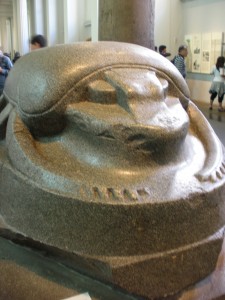
Scarab from the Egyptian section of the Museum - on the Touch TourSign for the Blind Touch Tour
I was struck again by the services provided for disabled/hard-of-hearing peoples tonight at the performance of All’s Well That Ends Well at the National Theatre. One of the last things I was expecting when I entered the theatre was to have a closed captioning screen for the play! Despite this service being aimed at those deaf/hard-of-hearing people, I benefited greatly from being able to see some of the dialogue I missed either by zoning out or simply not being able to hear. Although I did find the screens slightly distracting at times, I think that it was a brilliant idea that should be implemented at many more theatres in the world.
Overall, I am finding London to be a very mixed city of accessibility and services for people who are disabled or handicapped in some way. I think that the Tube stations need some work, but as construction is constantly being done on them, I know that they will be improved upon eventually. On the other hand, I think that the Touch Tour and the closed captioning in the theatre were both wonderful ideas that should be implemented in the States and around the world if they haven’t already. Any thoughts or observations on services and accessibility?
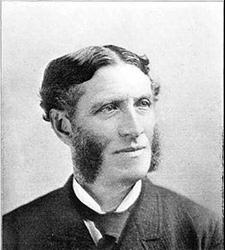
Mr. Arnold: enthusiastic about theatre AND a pair of mutton chops to die for
So said poet Matthew Arnold, more than eighty years before a National Theatre largely subsidized by the government, to which he referred, would actually come about. Last night I saw a good, fairly ambitious staging of All’s Well That Ends Well at the National Theatre for 10 Pounds. I, too, am wondering why this institution which serves as both promoter of theatre to the wider public and patron of the fringe and experimental, wasn’t part of British life sooner.
The last few days have truly been remarkable. I’ve gotten to see great, well acted productions of Stoppard and Shakespeare for free (for me at least). I’m fairly sure there’s nowhere else in the world that this could be done (without a great deal of generosity). After last night and tonight, I’m particularly regretful that I won’t be able to see many more great plays (because of time constraints) even though I’m spending a whole month in London and I might be reimbursed for it.
Anyway, I really did enjoy Arcadia, even if I’ll need to read it, see it again, and then read it again to even get a whiff of what Stoppard ultimately meant. I had the same feeling on reading Rosencrantz and Guildenstern are Dead only one time through (oh, and Travesties was the other play I was thinking of the other day).
All’s Well That Ends Well, despite being a sometimes infuriating play in terms of theme and (ironically) the ending, was also a valuable experience. Mr. Fisher would be happy to hear that I made a conscious effort to consider the lighting as part of the storytelling for probably the first time ever. In retrospect, the lighting went a long way towards creating a feel of a dark, imperfect fairy tale that I think this production was going for. The set design, which frankly is what really got me interested in coming back to see the play, was even better than I imagined.
Although one might expect a national theatre to put on spectacular stagings of Shakespeare in spaces that fit upwards of a thousand, the thing that struck me on our tour yesterday was that the National Theatre also devotes resources to creating and staging experimental work even if it will not appeal to the general public or bring back much money. Creating three spaces to fit the needs of very different plays when the Theatre was created is evidence that the Theatre is devoted to both offering inexpensive access to great productions and helping to foster a wide range of plays and playwrights.
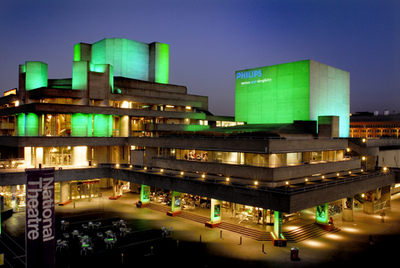
Stunning Photo of the NT at night
I wonder if Brits are aware of how spoiled they are compared to Americans in terms of having fine art subsidized and made somewhat affordable for them (maybe this is why they wear jeans to plays). Judging from the crowd at All’s Well (a near sellout on a Tuesday night three months into the production), they are appreciative of the National Theatre and want to support it. I can’t help thinking this is a great example of how a governmental investment in the fine arts can truly pay off, and how the United States should consider a greater investment in such artistic institutions which are beneficial to society in more ways than one.
While I don’t know if an institution exactly like the National would be feasible in America, I do know that seeing multiple great, professionally produced plays in the US often means going only to New York and spending hundreds and hundreds of dollars. While people spend that much in London, too, Mr. Fisher mentioned that the more innovative and ultimately worthwhile theatre is generally done by the cheaper, subsidized theatres. Also, although this might be hard to sell to constituents who understandably have government money in mind for other purposes, it’s just in a country’s interest to support the creation of great art. It’s great to see that this seems to be understood in Britain.
It has been awhile since I have actually stepped back and appreciated how much work and effort goes into a theatrical production. My last personal experience with a theatrical production was playing in the pit orchestra in a high school production of “How to Succeed in Business without Really Trying” during my sophomore year. The last time I had performed in a play or helped with costumes and set was in fifth grade. Needless to say, I had allowed myself to forget the hard work and dedication required to put on a successful theatrical production. Obviously I have attended numerous plays, musicals and operas since then, but I only viewed it as an audience member paying attention to the final product. I had forgotten to appreciate the intricacies of sets, costumes, rehearsals, props, and production staff. This held true even up until last night when we saw Arcadia. I loved the play and found the script to be beautifully written in order to convey a powerful message concerning time and how it passes. Yet the details of the lighting, set, props and backstage work escaped me.
It was not until this morning’s discussion with Rick Fisher that I began to understand the intricacies of lighting, sets, and other backstage work. I wish we could have talked with him before seeing Arcadia. Looking back, I can understand the importance of lighting beyond the obvious cues it provides. Truly, it made me more appreciative of the lighting design we experienced with Arcadia. It was simple but artistic in that it successfully conveyed not only the time of day but the difference in the time periods. At that time I had decided to appreciate the lighting and other backstage works of the plays we would be seeing in the rest of our time in London. I thought that would be the end of it. Yet, I found that our backstage tour at the National Theatre really drove home that point. Not only did it further my newfound appreciation for the collaborative effort required to produce a theatrical even, but it also revitalized my excitement for the theater. A few years had passed since I had been truly excited to see, experience and appreciate a theatrical production. But, with this new appreciation and insight about the production of a play I find myself with a new found passion for the theater. This is something I did not expect from our time in London. I thought I would find myself discovering passions for the city, its architecture, parks, museums, et cetera; not for theater. It is a wonderful discovery and one that will be far too easy to indulge in while we are here and in Norwich. Hopefully, I can take this with me when we return in June but for now I am more than content to take this new knowledge and explore the theaters and plays of London and Norwich.
I’m going to be perfectly honest: I’ve never been a big fan of the theater. I’m the sort of person who will go see anything and be able to appreciate it or be critical of it for seemingly valid reasons, but I’ve just never really enjoyed live theater the way I do films: the choice of only one or two settings has always felt extremely limited for my wild and vivid imagination, I’m a bit hard of hearing and can’t turn the volume up on live actors, people don’t suddenly break into coordinated song and dance routines in real life, there’s a huge margin of error for mistakes and unwelcome variation between performances, and it’s much harder to blow things up and create huge messes on a stage. I’m a fan of realism and authenticity, and sometimes I just can’t suspend my disbelief with plays the way I can with movies.
All of this being said, I’ve always been fascinated by the production aspect of live theater. I was heavily involved with the production and tech crews at my high school, and I used to enjoy nothing more than Hell Week before opening night, sitting in the black box theater in the wee hours of the morning, flicking lights on and off, organizing props, and putting finishing touches on the set. After hearing Rick Fisher speak about his experience with the theater and taking the tour of the National Theatre today, I’ve started longing to go back to stage managing and tech production. I’m attempting to see as many plays as I can during our time in London in order to try to condition myself into enjoying being an audience member, but I think I will always prefer being a part of the action rather than watching it. I kind of wonder if this is a problem: enjoying working very hard towards an end product you don’t really care for.
I’ve never been an avid play-goer before this trip, but I feel as though the West End has a bit less glitz and a bit more pride than Broadway. Perhaps pride is the wrong word, and perhaps I’ve been seeing and hearing of the wrong plays, but I often think of many Broadway plays as being a good and expensive night out, but the West End seems to treat the plays as more of an art form and something that everyone should be able to enjoy and appreciate. If the advertisements on the Tube are any judge, the West End has its fair share of mindless plays based on popular movies, but the simple fact that there are cheap seats, student discounts, overwhelming amounts of Shakespeare, government funding, and seemingly many more British film and television stars on the stage as well as the screen (working for meager amounts of money) makes me believe that in England, the theater is more of a cultural institution meant for everyone rather than deep appreciation for few, or simple entertainment.
I grew excited last night upon learning that Arcadia was written by Tom Stoppard, who also wrote Rosencrantz and Guildenstern are Dead and co-wrote Shakespeare in Love. I seemed to have forgotten, however, that his work, while usually hysterical and thought-provoking, is also very dense and requires a fine-toothed comb to find all of the hidden jokes, references, and subject matters. This, coupled with the fact that I was inexplicably exhausted and that my hearing can be likened to that of a seventy-year-old man’s made me unable to completely follow much of the play, but apparently I wasn’t alone. I think reading it would make things clearer.
I’m foregoing the next performance at the Globe simply because I don’t know if my back could handle another few hours as a groundling, but I’m attending All’s Well That Ends Well tomorrow night in its stead in a valiant effort to see more plays, learn to appreciate the finished product rather than just the behind-the-scenes work, and learn to like Shakespeare.







